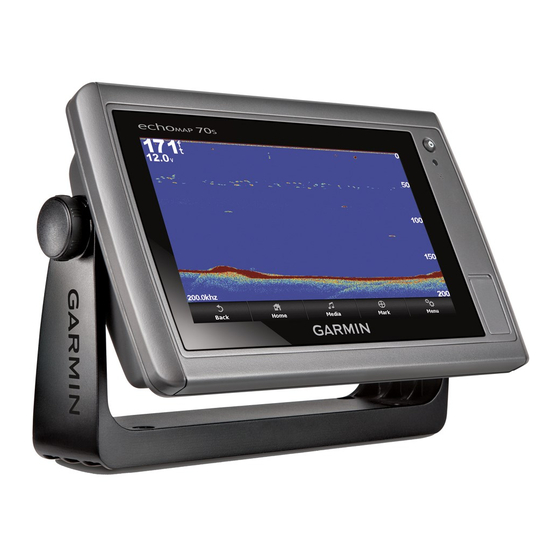the chartplotter is connected to a compatible marine wind
sensor. When in sailing mode, true and apparent wind are
shown on the wind rose.
Lake Level: Sets the present water level of the lake. This
feature is available only with some premium maps.
Overlay Numbers: Adjusts the data shown on the screen
(Overlay Numbers Settings, page
Weather: Sets which weather items are shown on the chart,
when the chartplotter is connected to a compatible weather
receiver with an active subscription. Requires a compatible,
connected antenna and an active subscription.
Chart Appearance: Sets the appearance of the different charts
and 3D chart views
(Chart Appearance Settings, page
Chart Appearance Settings
You can adjust the appearance of the different charts and 3D
chart views. Each setting is specific to the chart or chart view
being used.
NOTE: Not all settings apply to all charts and 3D chart views
and chartplotter models. Some options require premium maps or
connected accessories.
From a chart or 3D chart view, select MENU > Chart Setup >
Chart Appearance.
Orientation: Sets the perspective of the map.
Detail: Adjusts the amount of detail shown on the map, at
different zoom levels.
Heading Line: Shows and adjusts the heading line, which is a
line drawn on the map from the bow of the boat in the
direction of travel, and sets the data source for the heading
line.
Panoptix Area: Shows and hides the area being scanned by
the Panoptix
transducer. The attitude and heading reference
™
system (AHRS) must be calibrated use this feature
(Transducer Installation Settings, page
World Map: Uses either a basic world map or a shaded relief
map on the chart. These differences are visible only when
zoomed out too far to see the detailed charts.
Spot Depths: Turns on spot soundings and sets a dangerous
depth. Spot depths that are equal to or more shallow than the
dangerous depth are indicated by red text.
Shallow Shading: Sets the shades from the shoreline to the
specified depth.
Depth Range Shading: Specifies an upper and lower depth to
shade between.
Symbols: Shows and configures the appearance of various
symbols on the chart, such as the vessel icon, navaid
symbols, land POIs, and light sectors.
Style: Sets how the chart appears over 3D terrain.
Hazard Colors: Shows shallow water and land with a color
scale. Blue indicates deep water, yellow is shallow water, and
red is very shallow water.
Preferred Depth: Sets the appearance of a safe depth for the
Mariner's Eye 3D chart view.
NOTE: This setting affects only the appearance of hazard
colors for the Mariner's Eye 3D chart view. It does not affect
the safe water depth Auto Guidance setting or the sonar
shallow water alarm setting.
Range Rings: Shows and configures the appearance of range
rings, which help you to visualize distances in some chart
views.
Lane Width: Specifies the width of the navigation lane, which is
the magenta line in some chart views that indicates the
course to your destination.
Charts and 3D Chart Views
9).
9).
22).
Overlay Numbers Settings
From a chart, 3D chart view, the Radar screen, or a
Combinations screen, select MENU > Overlay Numbers.
From a chart, 3D chart view, or a Combinations screen, select
MENU > Overlay Numbers.
Edit Layout: Sets the layout of the data overlay, or data fields.
You can select the data to be shown within each data field.
Nav. Inset: Shows the navigation inset when the vessel is
navigating to a destination.
Navigation Inset Setup: Allows you to configure the navigation
inset to show Route Leg Info, and to control when the inset
appears before a turn or destination.
Compass Tape: Shows the compass tape data bar when the
vessel is navigating to a destination.
Editing the Data Fields
You can change the data shown in the overlay numbers
displayed on the charts and other screens.
1
From a screen that supports overlay numbers, select MENU.
2
If necessary, select Chart Setup.
3
Select Overlay Numbers > Edit Layout.
4
Select a layout.
5
Select a data field.
6
Select the type of data shown in the field.
Available data options vary based on the chartplotter.
Showing a Navigation Inset
You can control whether a navigation inset appears on some
chart views. The navigation inset is shown only when the boat is
navigating to a destination.
1
From a chart or 3D chart view, select MENU.
2
If necessary, select Chart Setup.
3
Select Overlay Numbers > Nav. Inset > Auto.
4
Select Navigation Inset Setup.
5
Complete an action:
• To show waypoint velocity made good (VMG) when
navigating a route with more than one leg, select Route
Leg Info > On.
• To show next-turn data based on distance, select Next
Turn > Distance.
• To show next-turn data based on time, select Next Turn >
Time.
• To indicate how the destination data appears, select
Destination, and select an option.
Setting the Heading and Course Over Ground Lines
You can show the heading line and the course over ground
(COG) line on the chart.
COG is your direction of movement. Heading is the direction the
bow of the boat is pointed, when a heading sensor is connected.
1
From a chart view, select MENU > Chart Setup > Chart
Appearance > Heading Line.
2
If necessary, select Source, and select an option:
• To automatically use the source available, select Auto.
• To use the GPS antenna heading for COG, select GPS
Heading (COG).
• To use data from a connected heading sensor, select
Heading.
• To use data from both a connected heading sensor and
the GPS antenna, select COG and Heading.
This displays both the heading line and the COG line on
the chart.
9

